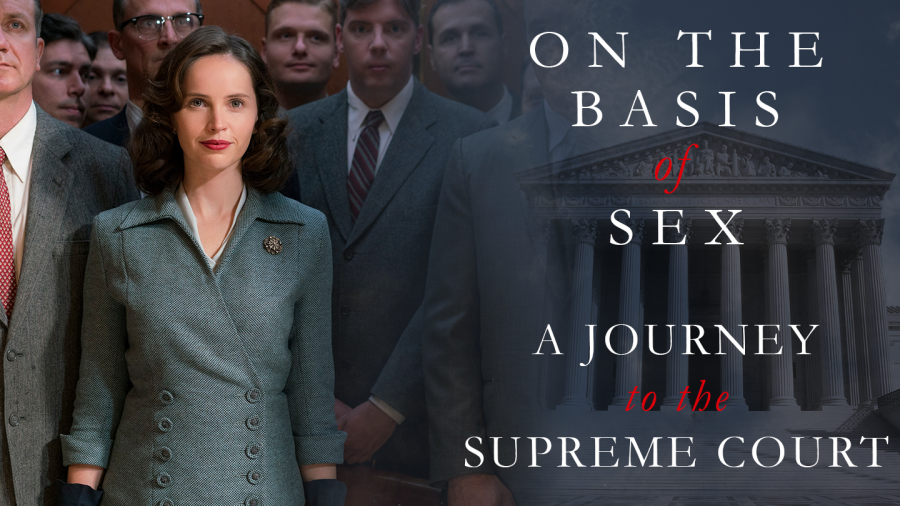A slew of Harvard Law students fill the screen as the film opens, and it’s not difficult to notice they’re overwhelmingly male. That is, until the camera finds Ruth Bader Ginsburg in the crowd, standing out not only because of her small stature, but also because she is one of the few female students enrolled in Harvard at the time.
While at Harvard, Ruth is constantly discriminated against based on her gender. In class, she is looked over and undermined. When all the new female students are invited to a dinner at the Dean’s home, they are required to give an “acceptable” reason as to why they were at Harvard, taking a spot that could have gone to a man. It is in these first few scenes that we witness the beginnings of Ruth’s fight against gender discrimination.
Parallel to her own fight against society is the relief that her relationship with husband Martin “Marty” Ginsburg brings. Martin is the only person who wholeheartedly believes in Ruth’s abilities and is not threatened by her intelligence. He is her equal partner, helping with the cooking and parenting. In the first half of the movie when the pair learns Marty has testicular cancer, Ruth must shoulder taking care of him, attending her classes and helping Marty through his coursework. They are by no means perfect. They fight and argue, but they always come back to supporting each other.
Felicity Jones plays Ruth with all the conviction and hope necessary to take on ingrained societal issues, but then is able to create the subtle tells of conflict and disappointment that come with every microaggression thrown at her. Her partner Marty, played by Armie Hammer, is well-acted in the same way. Marty is played as a strong family man, empathetic and supportive. They bounce off each other in the film, and although both do fall into the societal pitfalls of their time and sometimes passively accept the gendered comments they do not truly believe, it only helps to make them feel more real.
The second half of the movie shifts to the 1970s, and we see Ruth struggling to get hired into a law firm for no other reason than her gender. Employers think she’d be a distraction or a “ballbuster,” so eventually she resorts to taking a teaching job at Rutgers.
The focus of this second half is Ruth attempting to put what she preaches into action. The opportunity arises when Marty drops a tax law case onto her desk; and although she first declines reading it, she ultimately gives in and finds a possible entrance for her to break down the gender discrimination she has been fighting against so vehemently. From here the film’s pace begins to pick up and the actual law jargon of gender discrimination starts full force. After being beaten down so much in the first half, Ruth is renewed here with the hope of changing the precedent.
The case in question concerns gender discrimination against a man, a unique case that, if she wins, could topple the barriers that prohibit women in the very same swing. Charles Moritz is a bachelor who has hired a nurse to help him care for his elderly mother. He is being denied a tax deduction for the nursing service simply due to his gender. This is because at the time the law said that only a woman who is taking care of a family member or a husband whose wife needs the services could receive the deduction. It goes under the assumption that the woman is the caregiver, and those who wrote the law could never have foreseen a single man being the caregiver for his ailing mother.
Ruth partners up with American Civil Liberties Union (ACLU) lawyer Mel Wulf for the case, and although Mel fights for civil liberties, he is ultimately a realist. Hardened by the cases he has lost, Mel wants to help Ruth, but also knows when a case like Moritz’s is lost. Throughout this case, the audience is able to see a multitude of interpretations of how to change gendered law through a series of character interactions featuring Ruth, Mel, Ruth’s fierce feminist daughter Jane and civil rights activist Dorothy Kenyon. The later section of the movie includes debates on progress and how to change the precedent, as well as how to fight the case. The writers expect their audiences to be smart enough to understand the complexities of this push for progress, and they give us all the sides of the story.
In the climactic courthouse scene, we follow a basic cinematic layout where the underdog stumbles in the beginning only to persevere and win in the end. Ruth fumbles over her reasonings and ultimately forfeits an extra two minutes to her closing arguments when she first takes the stand. Things do not look bright for Mr. Moritz and the Ginsburgs in that instance, but when it comes time for closing arguments Ruth steps up. She gives a speech focused not on law, but sensibility and the changing of times, all of which warrant a change in the written law. She bases her case on changing the precedent and in the end successfully wins the case.
At the end we see a cameo of the real Ruth Bader Ginsburg climbing the steps of the Supreme Court. We are reminded of where this hero started and how she has become one of the most influential figures in not just politics but in culture today. The movie ends leaving audiences wanting more, to see more of her life, her founding of the ACLU Women’s Rights Project and her Supreme Court appointment. The plot is nothing different or unique, it simply follows the underdog who rises up to beat the system, but the characterization and inner workings of its source material is what makes it special.
Ashley Tsang can be reached at [email protected].





















peter most • Jan 29, 2019 at 9:20 am
Question.. Who was the first women supreme court judge?
Answer: Sandra Day O’Connor
Funny…. There is zero mention of Sandra Day O’Connor. This film isn’t about celebrating a women judge or a ‘hero’, it’s about celebrating a liberal. And who is the one who made progress and advance women’s placement in the justice system??
It wasn’t democrats, it wasnt jimmy carter, it wasn’t LBJ, it wasn’t JFK.. No it was a republican, Ronald Regan. Who sadly wasn’t mentioned in the movie, without his heroic challenge of status quo to appoint Sandra O’Connor..there would be no Ginsberg. Not to mention the extraordinary career of Sandra O’Connor